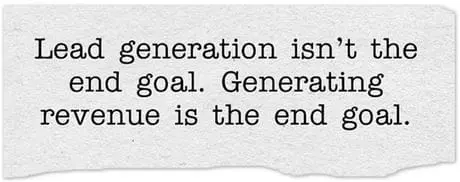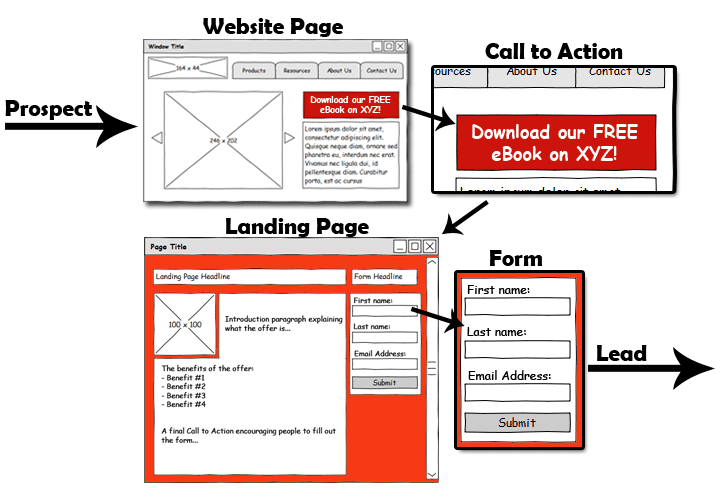What is a lead? A lead is a person who has indicated interest in your company’s product or service. Generating sales leads is a key component for the success of your company.

Online, a lead is traditionally defined as a person that completes a landing page. A landing page is a webpage with a form through which a person supplies contact and business
information in exchange for free information provided by a company, such as an ebook, webinar, product consultation, or product demonstration.
Having only a person’s email address does not make them a lead for your business. Instead, view that person as a contact. because they have provided their email address, possibly as a subscription for your blog or email newsletter, you now have the opportunity to use targeted and relevant email marketing efforts to convert this person into a lead.
The mechanics of lead generation
When driving leads online, a business needs to have a few key elements in place. From a tactical perspective, a marketer needs three crucial things to make inbound lead generation happen.
- Landing pages: A landing page is a website page that has one distinct purpose: lead generation. This page contains a form that captures contact information from a visitor in exchange for an offer. Check out our Landing pages ebook for more information on how to build awesome landing pages.
- Offer: An offer, in the context of lead generation, is some sort of content or product that is of enough value for a person to provide contact information in exchange for access to it. traditional lead generation offers include: ebooks, whitepapers, webinars, free consultations, and product demonstrations.
- Call-to-Action: Landing pages and offers are useless if no one sees them. To send people to a landing page, you need a call-to-action. Often abbreviated as CTA, a call-to-action is text, an image or button that links directly to a landing page. Check out our call-to-Action ebook for more information on how to create and place calls-to-action effectively.
 As an example, let’s say a person visits your and sees and clicks a call-to-action on your homepage. The call-to-action takes that person to your landing page where they see a description of your offer (including the benefits of your offer) and have the option to complete and submit the form on the landing page. Once they submit the form, they receive your offer and your sales team has a new lead to contact.
As an example, let’s say a person visits your and sees and clicks a call-to-action on your homepage. The call-to-action takes that person to your landing page where they see a description of your offer (including the benefits of your offer) and have the option to complete and submit the form on the landing page. Once they submit the form, they receive your offer and your sales team has a new lead to contact.

With this understanding of the basic lead generation process, we can now look at 20 best practices.
20 best practices for lead generation success
1. Improve positioning of your calls-to-action (CTAs)
Calls-to-action do best “above the fold” – the space where your webpage is viewable to the user without having to scroll down. According to heat map analysis, anything “below the fold” will only be viewed by 50% of people who visit your page. Doubling impressions on your CTAs can significantly increase your lead count.
2. Be more clear about exactly what you’re offering
Be crystal clear about what the offer is in your CTA. And be specific. If you’re giving away a free guide, say “Download our FREE guide to x”. If you’re hosting a free webinar, say “Register for our FREE webinar on x.” x should clearly convey
a compelling benefit of receiving the offer. This is much more effective than “Download Now” or “Get a Free Article.” These simply aren’t specific enough.
3. Use images, not just text
Images stand out on a webpage more than text does, and get a lot more attention, as proven by the heat map study. Additionally, using an image will allow you to show off the offer in a way that you can’t necessarily convey using text alone.
4. Use colors that contrast with your site color scheme
Your web designer might kick and scream about this, but if your call-to-action blends in too much with your site design, it won’t stand out as much. You want as many eyeballs to land on that call-to-action as possible, so use contrasting colors to make the CTA stand out.
5. Make your CTA a hyperlink to the corresponding landing page
You’d be surprised how many times I’ve seen calls-to-action that aren’t links. Whether intentional or a matter of forgetfulness, not linking the CTA to your landing page will make it much harder for visitors to find out how to get the offer, and they’ll likely give up. So double, triple, and quadruple check to make sure all of your CTAs link to their corresponding landing pages.
6. Place CTAs on the most relevant pages
CTAs shouldn’t be one size fits all. If your company offers various products or services, you may want to consider creating a different offer for each of them. Then you can place CTAs linking to each offer on the website pages that are most relevant to that offer.
7. Add CTA’s to every blog post
Whenever you create a new blog post, choose an offer that’s most relevant to the content of the post. Then add a call-to-action to the bottom of that blog post linking to the landing page for that offer. Informational offers such as ebooks, guides, and webinars do very well in this space, because people reading your blog likely be eager to get more free information from you.
8. Match the headline of the landing page to the corresponding CTA
Keep your messaging consistent on both your CTA and the headline of the landing page. If people click on a link for a free offer and then find out there’s a catch on the landing page, you’ll instantly lose their trust. Similarly, if the headline reads differently than the CTA, it might lead to confusion, and the visitor might wonder if the CTA is linked to the wrong page.
9. Be more clear about what you’re offering on landing pages.
This is the biggest mistake I see in landing pages. people often try to be too clever or witty in the headline, and it’s not clear what the offer actually is. Again, if you’re giving away a free guide, say “Download our FREE Guide to Improving x”. plain and simple.
10. Improve the positioning of the form
Just like you want to have your call-to-action above the fold, it’s ideal for the form to be above the fold as well. This way, there can’t be any confusion as to what’s expected from the viewer on this page: they need to fill out the form to get what you’re offering.
11. Keep the form as simple as possible
“Simple” does not always mean “short.” what you ask for on a form should match the information your sales team needs from your leads to make the sale. For top of the buying cycle folks at the beginning of their research process, name and email address might suffice. For more committed prospects at the bottom of the buying cycle, you might want to ask for some qualifiers like job title or city/state, and perhaps ask for a phone number. Just try not to ask for more than what’s necessary.
12. Use images to show off what you’re offering
Your landing page doesn’t have to be a visual masterpiece, but it should show what your offer is all about. If your business is something a bit more abstract, just take a screenshot of your guide/whitepaper/eBook/etc. and add the image to your landing page. You can use freeware like Jing to easily capture and save screenshots.
13. Keep the text concise and easy to scan
Be brief and to the point; it’s in the offer itself where you give more information. In addition to your headline, include a brief paragraph explaining what the offer is, followed by a few bullet points outlining the benefits of the offer.
14. Emphasize the benefits of the offer
Make it clear in your brief paragraph and/or bullet points what the benefits of the offer are. It’s more than just listing what the offer is comprised of; it takes a bit of spin. Instead of “Includes specifications of product XYZ,” say something like “Find out how XYZ can increase productivity by 50%.” In other words, convey the value of your offer clearly and effectively.
15. Remove links and navigation to maintain focus
When a prospect reaches your landing page, you’re just a few keystrokes away from getting their contact information. So don’t distract them with links that will take them further away from your goal of getting a lead. The thank you page, to which you direct your prospects after they fill out your form and become leads, will give you the opportunity to return the navigation and links to other parts of your site.
16. Create a thank you page that keeps new leads on the site
When creating a thank you page, not only can you bring back the navigation, but you can provide other links to keep the lead engaged. You can include calls-to-action to the next step in the buying cycle, link to your blog, encourage them to
follow you on Twitter, ask them to subscribe to your newsletter, and more. You can do a lot more with your thank you pages than just adding tracking code!
17. Make sure your offers are compelling
Your landing page should always be able to answer the question: “What’s in it for me?” Things like pricing brochures, specs, and self-promotional videos are not compelling offers, because they do not provide enough value to answer that question. Informational items like whitepapers, guides, and webinars are compelling offers because they do. See the difference?
18. Link back to your site in your offer
Although lead nurturing is a very powerful tool, you should provide a way for your leads to find you again besides email, especially if they are more inclined to ignore email from people they don’t know. If they enjoyed your whitepaper (which is full of remarkable content, so of course they did!), make it easy for them to remember where they got the whitepaper from by linking to your site on your cover page.
19. Create offers for each phase of the buying cycle
Just like your forms might vary for each phase of the buying cycle, your offers should as well. Someone at the top of the buying cycle may be more interested in an informational piece like a guide or ebook, whereas someone more committed at the bottom of the cycle might be more interested in a free trial or demo. You don’t need to pick and choose; create offers for each phase, and include a primary and secondary CTA to these offers on various pages throughout your site.
20. Be more clear about what you’re offering with your email copy
I’m being repetitive about this for a reason: I’ve seen this mistake made too many times, and it’s such an easy fix. Always be crystal clear about what you are offering. Keep your email short and sweet. Instead of prefacing your offer with two paragraphs about your company’s background, get to the point. What are the tips you want to share with your prospects? How can they benefit from subscribing to your blog? Why should they care what new offer you have on your site?
Get a free review of your existing lead generation process and learn some easy, inexpensive changes you can make to generate more high-quality leads from your website.





